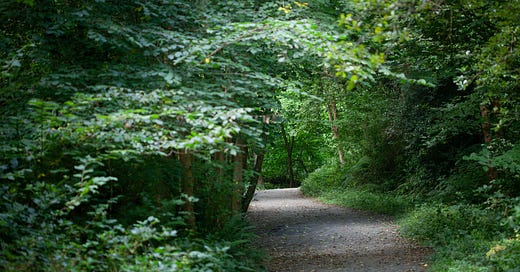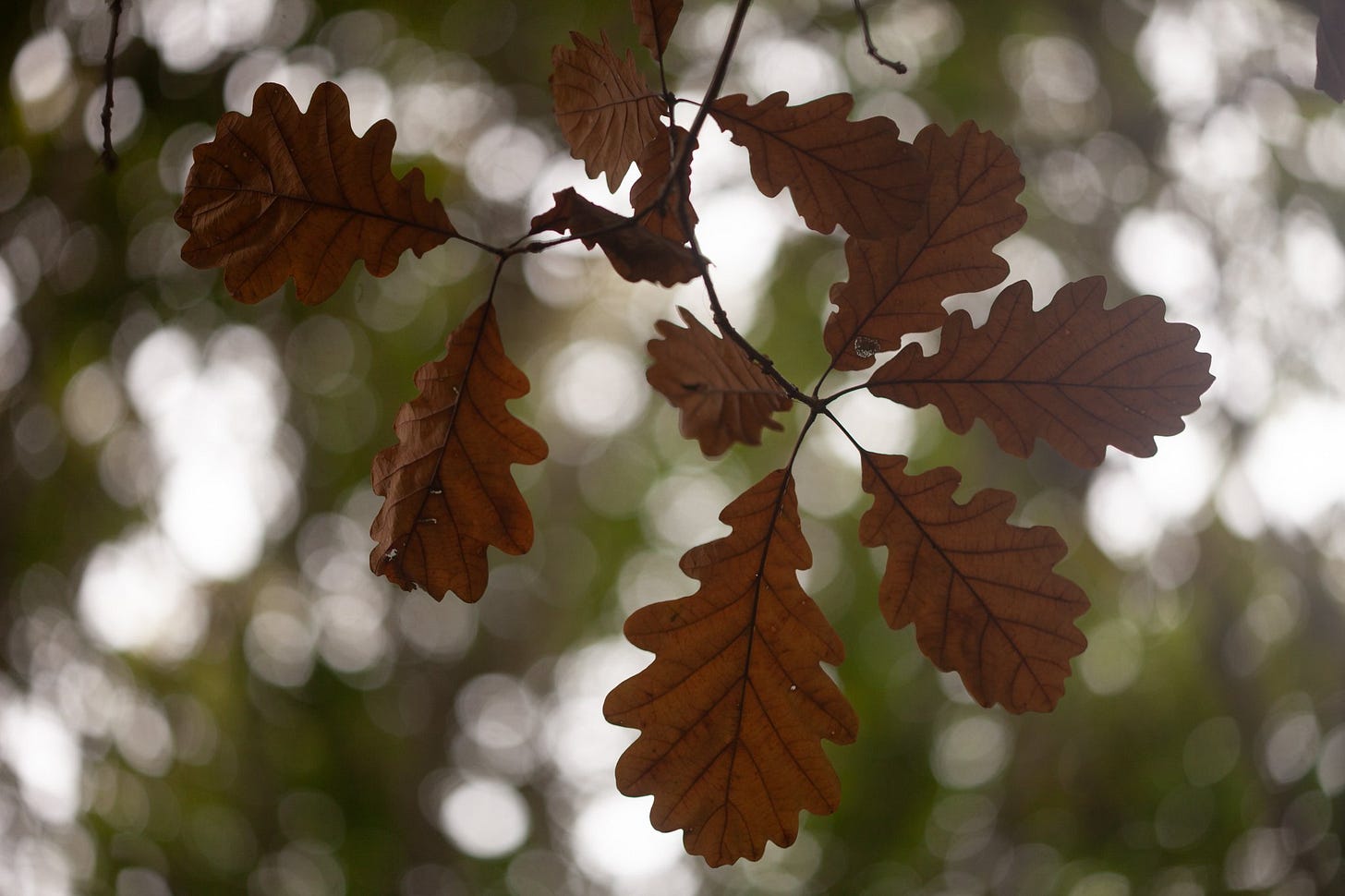In a field by the oaks near a church on the hill
from the Shaking Bog Festival, Wicklow, Ireland.
You can listen to this piece here, and at the bottom of the post. Paid subscribers will find a series of creative prompts to support your refections.
October has come with its attendant twists. The season turns towards the dark; migrant swallows have fled from the skies; leaves are in their dance to fade. As the evening draws it’s cloak, it’s an open passage to the night, where fires spark and long awaiting stacks of books, ideas, poems and stirrings sit in anticipation of witness, of writing. As spring sends postcards from the other side of the world, I twist a leaf from the Celtic calendar and let the turning inwards commence. It’s like permission from the skies to arrive at the blank page; to let it do it’s tricks on me. For it is here, I am ever more convinced, that the stories which are written there, and the cultures that they shift, the world is made.
I’ve been thinking more than ordinarily about the role of art, literature and poetry in these dark times. I’ve been thinking of is necessity, and absurdity. I’ve been thinking how stories are like the thread, holding things in place, just about. I’m thinking, sometimes we need to pull the thread tighter. I’m thinking, this is one of those times.
Last month, I travelled up to Co. Wicklow to attend a festival called ‘The Shaking Bog’ — a community led curatorial treat, gathering artists, writers, film-makers, musicians, performers and educators for a weekend to honour the nexus of art and nature. At the centre of it all was a nested set of questions: what if art could, as the organises urge, ‘reawaken and illuminate our often forgotten connection to the natural world - to biodiversity, heritage and place, but also to our deepest impulse to belong, to nurture and to care’.
And in the centre of it all, what I found there was something akin to a word I don’t use lightly, nor without some corresponding nuance; a word which is so often over subscribed, yet undervalued. Hope.
In finding hope, found something else there too: an affirmation of the collective power of art in the dark times, and by that I don’t just mean winter, but these days as a whole, in which I need not remind you of the nexus of complex political crises, biodiversity collapse, of homelands and heartlands in turmoil. It’s heavy out there.
Yet, yet…
There is a church on a hill beyond the woods, where for a while the church is more than a church. The woods are home to the sessile oak. In the aisles of the church as the people speak of efforts to protect the oak, they know they are also protecting themselves. In the church on the hill by the oak, there is a man speaking about his encounter with a grey whale, and how the encounter with the eye of that great creaturely presence was an encounter with a sentience beyond the depths of soul. In the church on the hill there is a poet. Her hair is white with wisdom and she wears it braided down her back, so much of it to carry. Her poems are weavers of a different kind; of mythic incantations to the feminine divine, and to the muse herself, embodied. The church on the hill is full of listeners. On a dark star studded night, poetry has a new altar in the hearts of the seekers.
The alter plays host to other music too. There is the master of the fiddle, who spins tunes which speak to the power of place and the landscapes which shaped them. Between the pulpit and a cross, there is a travelling song collector, who has been gathering the tales and stories from a time when song and story were currencies of understanding larger cycles of time, place and collective memory. The church is not about the church.
And so it continued.
In a postbox near the church on the hill there is a short film about the oaks and the mountains and the valley which shapes the soul of the place. In the centre in the woods, the children are printing on bunting, learning a new way of making patterns, and there is man hand-building bat boxes.
The culture starts to shift in churches on the hills, and bat box building and new patterns in the hands of children.
In a field by the valley, the sun emerges and sets the leaves to golden. The song collector leads us into circle, suggests we take our shoes off, tells us about perception in the souls of our feet; about how we have forgotten so many of the wayfinding ways. He tells us about finding our footing through sensory perception with our whole selves, and invites us to place blindfolds on. We put our hands on each other’s shoulders, and like a tight braid, we are guided to an open field, which we are blind to now, except we are not. Our ears are our eyes. Our skin is our guide. The field is breathing around us, so alive to itself it is singing its song of welcome.
The field is where culture shifts.
In my toes I follow the grasses. There are stories in my feet. In my ears I follow a drum. Someone is calling us. In my bones I feel the old way. In my skin I let the song carry. In my eyes, in my eyes, in my eyes.
I am a young girl, blindfolded, being led to her death for speaking out.
I am a refugee, walking across a border to save my life.
I am a mother, leading her child across a threshold to the unknown.
I am a young girl, from a country so carnaged through an ill-justified story of politics and progress that I can no longer carry the weight of my belonging.
I leave the blindfold on.
In a field by the hill by the oaks by the church, I can feel all these things because of the field on the hill by the oaks by the church. I can hear the music of the fiddler. And I can find the map in my feet again, because of the blindfold from the story-gatherer.
The ground is the place where new stories are born. And the church, and the song, and the hope.
Culture shifts in these moments. Poem by poem. Note by note. Step by step. Not one. But many.
In the centre of it all, of the church, of the field of the blindfold, I walk into a new nest of questions. It starts with what if.
What if we flooded the world we stories of valleys and oaks and women who walk across borders. What if there were stories of whales with eyes so deep with soul they can change a life forever. What if it was not just one church on a hill, but many. What if it was not just one story collector, or poet, or song, or homemaker for bats. Not one rung of bunting. Not one weekend.
What if the story was so collectively strong it could tear down policies, the ones that make the women flee. What if the story was so empowering, that it could make a valley fill with oaks again, which became a policy, which became a new culture of planting, not just oaks, but other life-giving things. What if there were more of us; the song-carriers, the story givers, the planters, the fiddlers, the print makers, the people who open their churches, and homes and hearts to let the story in.
What if.
As the dark takes over the day, I light a candle and hear the fire crackle. The page is blank and inviting me to walk into it.
I am finding my way, pulling the thread, blindfolded.
It’s how I know the culture shifts.
Creative Prompts
Keep reading with a 7-day free trial
Subscribe to The Wild Edge - with Clare Mulvany to keep reading this post and get 7 days of free access to the full post archives.






